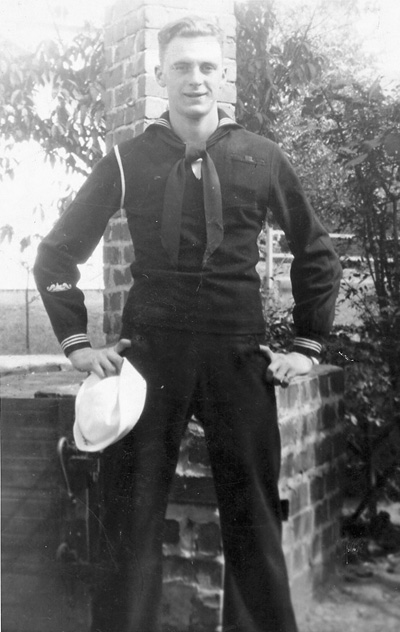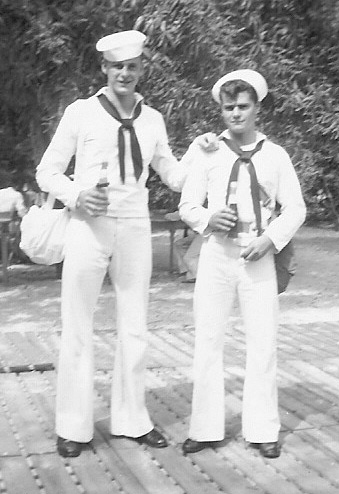| |
Legends recently received the following correspondance from Dr. Jim Allen, son of Wahoo crewman James Allen: "Here are two pictures of my Dad, James H. Allen. The one in the dark uniform would be about Feb. 1942. He had just finished sub school in MI. He was approximately 16 years of age.
The second is my dad and a friend when he arrived in Hawaii, 1942. I believe it was taken at a picnic at Pearl for the newly arrived."
Allen served in Wahoo during her second war patrol before transferring to the Silversides, then the submarine tender USS Sperry. In the February 1993 issue of "Polaris", the magazine of the US SubVets of WWII, he recalled two hilarious incidences from his time aboard her. A Lighter Side Of Pearl Harbor By James H. Allen (Wahoo & Silversides) It's tough to remember exact dates from 50 years ago, but I believe it was mid 1943, and I was in Submarine Division 102, on board the sub-tender, USS Sperry. We were tied at the long dock of the Sub-Base in Pearl Harbor. With no duties at the time, I wandered to the bridge where there was a great view of the base and Navy Yard. There were a few boats tied up at the finger piers off to port. One was firing water slugs from the stern tubes. For the uninitiated, this involves going through all steps to fire a torpedo except there's no torpedo involved, at least there's not supposed to be a torpedo in the tube. The tube is filled with water, and the procedure allows a full check of the firing circuits. Every time I would hear the "whoomp" of the water slugs, I would glance in that direction and note the disturbance of the water boiling up at the stern. When the third or fourth slug was fired, I was flabbergasted to see a torpedo wake streaking out across the harbor in the direction of the Navy Yard. The bridge of the Sperry must be 100 to 150 feet above the water line, so I had a panoramic view. The wake was headed straight at the stern of a freighter docked broadside to the speeding torpedo. I believe I was the only eyewitness; however, I was sure the crewmembers who had fired the "slug" knew something was different. I remember thinking that maybe there was ammunition on board that freighter, but I could not move. I could not take my eyes off the wake. My recollection is that the procedure for firing water slugs calls for maximum depth setting, and when the torpedo was about 100 to 200 feet short of the freighter it must have hit bottom. There was a gigantlc explosion. A geyser of mud and water shot into the air, the stern of the freighter seemed to lift 10 or 20 feet and slam back down. A shock wave traveled through the water and through the air, and jarred the Sperry when it hit. Water and mud was raining down out of the sky, and a big circular wave was rushing away from the point of detonation. A period of calmness followed, which seemed like several minutes elapsed, but was probably only a few seconds. I hear running footsteps, and became aware that signal lights were flashing all over the place while the Sperry bugler was blowing General Quarters. Moments later General Quarters was sounded for the whole base and Navy Yard. The bridge of the Sperry quickly filled with more brass than I had ever seen in one place, and General Quarters was "gonging" away. Men in battle helmets and life preservers were rushing up and down ladders and along the deck. Ammunition was broken out for the 20 and 40mm AA guns, and the 5" gun turrets came alive. Over the loud speaker "single up all lines, prepare to get underway. I heard the Captain order the Signalman to ask the Water Tower at the Navy Yard (the center of communication) "Are we under attack?" Gathering courage I stepped forward with a snappy salute an said Sir, I can explain;' and that's as far as I got when one of the Officers growled, "Do you have a battle station? Then get to it." Stammering, I said "But, but, Sir." That's all I got out. I was ordered to my battle station or the Master at Arms would have me on report. (My battle station was in the magazine of the after 5" gun, loading shells into a vertical hoist.) Eventually, the guys who fired the torpedo came forward and admitted their goof. In another few minutes we were secured from General Quarters and things just went back to normal. I never did come forward as probably the only eyewitness. Not long after the "water slug" incident, my buddy Keith and I were returning to the Sperry after having a couple of beers. This was still a period of relative inactivity and we were bored. As we approached the Sperry gangway, Keith pointed out several large empty wooden crates that had contained either 20mm or 40mm guns. Each box was a couple feet square at the end and 6 or 7 feet long. Keith said, "Let's make some kinda boat or canoe out of these boxes." "How come you always get the great ideas after two beers?" I thought it was really "beer talk;' but the next day Keith had a sketch of a blunt-nosed canoe with five gallon "alky" cans as out-riggers. We moved a couple of crates to the far end of the pier away from eyes, traffic and activities. We nosed around a paint locker on the pier and came up with a couple of almost empty tar buckets, and a handful of nails. We caulked all seams, mounted the out-rigger cans, made two paddles, and early next morning was ready to launch. The launch site was from a pier 100 feet or more from the stern of the Sperry. Our boat was difficult to maneuver but we were delighted with our handiwork. We were able to paddle under the big pier where the Sperry was tied. This was great as we could get out of sight if we heard or saw someone coming. About mid-morning I remembered a dental appointment. Rather than paddle back to the end of the pier, we went to the stern of the Sperry where a ladder was hanging over the side. Keith said he would paddle back to the end of the pier and find a place to tie up, out of sight, and see me in the mess hall for lunch. My visit to the dentist didn't take Iong. His office was close to the Boat Deck so I headed for my favorite spot near the Bridge to have a look around before chow. I was amazed to see a flurry of activity on the Bridge. The Captain was there with several officers, a signalman, and the Chief Master at Arms. They were all looking through binoculars a couple of points off the starboard bow towards the middle of the harbor. Signals were flashing all over the place. Remembering the recent emotional trauma of being ordered off the bridge at the time of the "water slug" incident, I wasn't anxious to get very close to this assemblage of brass. I heard someone say, What do you suppose it is?" "It looks like a man floating in some kind of wooden box. ''That last statement got my attention. My stomach muscles tightened into knots. I asked one of the Signalmen if I could have a quick look with his binoculars. To my horror, I saw poor Keith paddling like a mad man but tide and wind carried him farther into the middle of the harbor. Coming from the left, I saw a motor launch approaching with three or four Shore Patrolmen on board. I realized the whole harbor was on the verge of going to General Quarters with the intrusion of a strange, unidentified vessel. I heard the Captain say, "Whoever he is, he better not be from this ship." With that, the Shore Patrolmen threw a line to Keith and he pointed towards the Sperry. Somebody said, "My God, he's pointing this way," and the Captain said, through clenched teeth, "What the hell it that thing? If he's from this ship, he's headed for the brig. What an embarrassment." The launch brought Keith over to the pier where the Sperry was docked. He untied the towline and tried to paddIe under the pier and disappear but the Chief Master at Arms was waiting for him and he surrendered without a struggle. I didn't sleep that night knowing I would soon join Keith in the brig. I was waiting far the loud speakers to announce, "Fireman James Allen report to the Officer of the Deck." A couple of days passed and nothing more was said. I heard Keith had been taken to the SickBay so I went there. They told me he was at the AlEA Heights Naval Hospital, Psychiatric Ward. On my next liberty, I hitchhiked to the hospital and there was Keith with a big grin on his face. He told me they would probably give him a medical discharge, and if I wanted out, he would tell them I helped build the boat. I was relieved to learn that my involvement was not known, but stupefied at the prospects of being discharged under these circumstances. If Keith was crazy, it was "like a fox." But within a couple of weeks I received a letter from him, postmarked "San Francisco, California;" saying he had returned stateside on the S.S. Lurline. He said they had taken him from the boat in a "mental hearse" (his words for an ambulance) to a Naval Hospital in San Francisco, and he expected to be discharged by the time I received his letter. The next letter was from the East Coast. Keith had joined the Merchant Marine and would be on Atlantic convoy duty. Article excerpt copyright 1993 Polaris/US SubVets of WWII, Inc. |

